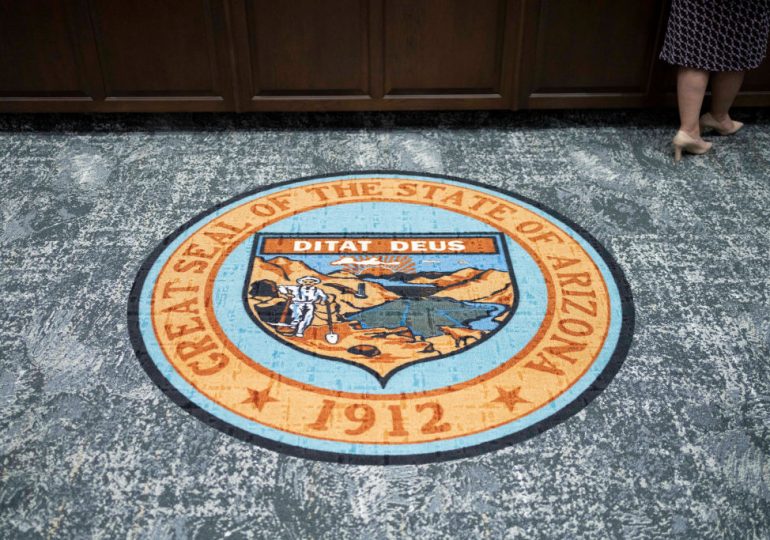Arizona’s extreme anti-abortion law, which dates to 1864, might finally be on its way out on Wednesday.
The law had been made moot by Roe v. Wade in 1973. But on April 8, 2024, the Arizona Supreme Court ruled that when the U.S. Supreme Court abolished the right to an abortion in 2022, the 1864 law snapped back into place, prohibiting all abortions except for those necessary to save the life of the mother.
[time-brightcove not-tgx=”true”]
Chaos and flip-flopping ensued. On April 24, three Republicans in the state house joined with all Democrats to pass a repeal. The state senate plans to vote on the matter on Wednesday. If the repeal passes, Democratic governor Katie Hobbs has promised to sign the bill, thus returning Arizona to a more moderate ban on abortions after 15 weeks, which was enacted in 2022. That law has broad support, unlike the more total ban — which probably never came close to majority support, even in 1864.
That’s because the men who passed that law represented only a fraction of Arizona’s population. The territorial legislature enacted the law before women could vote. What’s more, most of Arizona’s residents were American Indians, none of whom had access to the vote, and Mexican Americans, very few of whom did.
In fact, the laws passed by the legislature didn’t really even apply to most of the territory. Instead, American Indians, among them the various Apache groups who had not yet surrendered to the U.S. government, controlled most of the geography of the state. That meant that the authority of the young government that passed the abortion law was more a fiction than a reality — even though the ramifications of the laws they enacted are still reverberating today.
Congress created the Arizona Territory in 1863, by separating it from New Mexico. Arizona had no railroad, no mail service, and no public schools. The first territorial government was ad hoc at best. Legislators were elected, but, as in all territories, executive positions were appointed by the President. Prescott, the first territorial capital, was a small gold-mining camp.
The legislature met in a two-room log cabin that still smelled of pine pitch, had holes for windows, and a dirt floor. The house assembly had 18 members; the senate only nine. Three of the 27 were of Mexican origin, all of them wealthy ranchers, who did not represent most Arizonans.
Altogether, these circumstances meant that the laws they enacted did not necessarily represent the will of Arizonans. In 1864, roughly 600 Anglos, almost all men, and approximately 6,000 Mexican-Americans lived in the territory. But many of the latter were not counted by the official census taker, who was a “lawman and gunfighter” that they might well have wanted to avoid. The official census also did not even attempt to count the territory’s roughly 4,000 American Indians.
Read More: After Abortion Ban, Arizona Just Became the Most Important State in 2024 Politics
Most of the women in the territory were Mexican or American Indian, and they had no formal voice in the political realm. The 1864 territorial census found 40 women living in the Prescott area, 31 of whom were Mexican. More than half of them lived with men as what the census taker labeled “mistresses,” but would be more accurately described as common-law wives.
Only a handful of Anglo women lived in the region, which gave them some social influence and flexibility to make money, but no political power. Mary Sawyer was a cross-dresser, someone ew might call transgender today, who dressed as a man, worked mining claims with men, and drank with them as well. Another, Mary DeCrow, had come to Arizona with her southern companion, “Negro Brown.” She soon left him for a Mexican American blacksmith, Cornelius Ramos. She later ran a small restaurant.
These women proved to be transient as well. The census found only 10 of the 50 women in central Arizona in 1864 were still there by 1870. People came and went in mining camps, but the anti-abortion law may have repelled some women — especially because it prescribed a sentence of two to four years to anyone who provided an abortion. In those years, it was likely that abortion providers were fellow women.
Thus, the territory’s new laws quite literally represented the views of a small group of white men, not the broader Arizona public. The abortion law was part of an omnibus legislative package, called the Howell Code, that became Arizona’s first legal system. It made no exceptions for rape or incest, but very few acts we would understand as rape even counted as such at the time. The rape of Native and Hispanic women was widespread but almost never acknowledged, marital rape did not yet exist as a legal concept, and the age of sexual consent for girls was 10 years old. Until 1871, non-whites could not even legally testify against whites in Arizona courtrooms, and, according to historian Katrina Jagodinsky, “no Indigenous woman testified against a white defendant until 1913.”
In addition, the particular men in the territorial legislature were especially awful in their treatment of women. The speaker of the house, William Claude Jones, was a known pedophile. The legislature he presided over legalized a system of Indian “apprenticeship” that amounted to slavery. This law allowed one legislator, territorial militia Lieutenant Colonel King Woolsey, to keep as his consort 10-year-old Lucía Martinez. He had captured the young Yaqui girl during his self-proclaimed “extermination” plan in which he murdered 30 Apaches. By age 17, she had borne three children. After Woolsey married a white woman, Martinez went to court and won back the daughters Woolsey kept from her.
Woolsey’s story illustrates something important: Arizona’s first legislators were more concerned with controlling and killing Indians than they were with women’s rights. After passing the Howell Code, that first legislature spent most of its time debating how to fight the Apaches.
Read More: What to Know About the Arizona Supreme Court Abortion Ban Ruling
The war on indigenous people involved rape, as the fate of the largest tribal group in Arizona, the Diné, or Navajo, made clear. After a violent U.S. military campaign led by Indian Agent Kit Carson, the Diné were removed from Arizona and forced on the over 200-mile “Long Walk” to a remote reservation in New Mexico. The soldiers did “not have any regard for the women folks,” one white man recalled. “They took unto themselves for wives somebody else’s wife,” and killed husbands who resisted.
The territorial law gave these women no recourse if they became pregnant — despite the fact that, for the Diné, pregnancy was a deeply private matter and women had a say in politics and governance. In 1868, when the Diné successfully negotiated for a reservation on their homeland, it was men and women who did so. Later tribal law even emphasized the right to privacy, and polls suggest most tribal members in the Southwest support reproductive rights.
Even so, American Indians were entirely excluded from participating in Arizona politics, not just in the 1860s, but for decades to come. White women in the state secured the franchise in 1912, but Native peoples did not gain the right to U.S. citizenship until 1924. In Arizona, many fought for suffrage long after that, including through the use of the Voting Rights Act after it passed in 1965.
Given the exclusion of women, American Indians, and Mexican Americans from the political process that elected the territorial legislature, it is safe to say that the 1864 abortion law probably has never represented the views of the majority of Arizonans. Twentieth-century Arizona history supports that idea.
Take the state’s legendary conservative Republican U.S. Senator Barry Goldwater. With her father’s support, Goldwater’s daughter had an abortion in 1956, and his wife Peggy won Planned Parenthood’s national Margaret Sanger Award in 1967 for her decades of reproductive-rights activism. The Goldwaters, like many others in Arizona, embraced a libertarian conservative philosophy that rejected the sort of infringement upon liberty represented by the abortion law.
And this spirit persists to the present day. A recent poll (Indivisible/Data for Progress) found that 60% of Arizona voters identified as “pro-choice.” That includes Attorney General Kris Mayes, who grew up on a tree farm in Prescott, the former capital, and is the first mother to serve as Arizona’s attorney general. She has made it clear that she will not enforce the law those benighted men passed in her hometown 160 years ago. Finally, it appears the current legislature is following her lead to represent the actual views of most Arizonans.
Katherine Benton-Cohen is professor of history at Georgetown University. An Arizona native, she is the author of many articles, and two books. Her first book, Borderline Americans: Racial Division and Labor War in the Arizona Borderlands, was voted a Southwest Book of the Year and one of the fifty best books about Arizona. She is currently living in Bisbee, Ariz., with her family.
Made by History takes readers beyond the headlines with articles written and edited by professional historians. Learn more about Made by History at TIME here. Opinions expressed do not necessarily reflect the views of TIME editors.
Leave a comment








